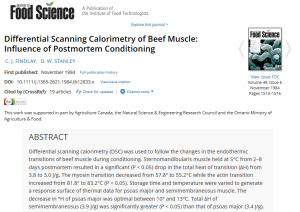Differential scanning calorimetry of beef muscle: Influence of postmortem conditioning
 Differential scanning calorimetry (DSC) was used to follow the changes in the endothermic transitions of beef muscle during conditioning. Sternomandibularis muscle held at 5ºC from 2-8 days post-mortem resulted in a significant (P < 0.05) drop in total heat of transition (ΔH) from 3.8 to 3.0 J/g. The myosin transition decreased from 57.8º to 55.2ºC while the actin transition increased from 81.8º to 83.2º (P < 0.05). Storage time and temperature were varied to generate a response surface of thermal data for psoas major and semimembraneous muscle. The decrease in ΔH of psoas major was optimal between 10 º and 13 ºC. Total ΔH of semimembraneous (3.9 J/g) was significantly greater (P < 0.05) than that of psoas major (3.4 J/g).
Differential scanning calorimetry (DSC) was used to follow the changes in the endothermic transitions of beef muscle during conditioning. Sternomandibularis muscle held at 5ºC from 2-8 days post-mortem resulted in a significant (P < 0.05) drop in total heat of transition (ΔH) from 3.8 to 3.0 J/g. The myosin transition decreased from 57.8º to 55.2ºC while the actin transition increased from 81.8º to 83.2º (P < 0.05). Storage time and temperature were varied to generate a response surface of thermal data for psoas major and semimembraneous muscle. The decrease in ΔH of psoas major was optimal between 10 º and 13 ºC. Total ΔH of semimembraneous (3.9 J/g) was significantly greater (P < 0.05) than that of psoas major (3.4 J/g).
![]()
Findlay, C.J., Stanley, D.W. (1984). Differential scanning calorimetry of beef muscle: Influence of postmortem conditioning. Journal of Food Science, 49(6), 1513-1516.